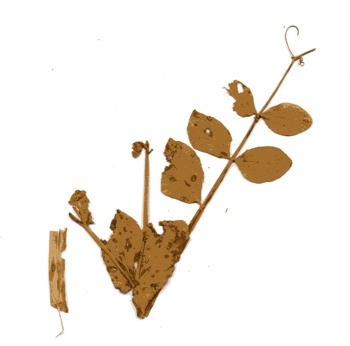Diseases
Colletotrichum pisi Pat. - Anthracnose of Peas
Systematic posicion.
Class Deuteromycota, superorder Ceolomycetes, order Melanconiales, family Melanconiaceae, genus Colletotrichum.Biological group.
This species is a Saprobiont.Morphology and biology.
Infected seeds and vegetation residues are sources of the infection. The disease affects all above ground parts of plants. Irregularly-shaped grayish-smoky or brown spots are formed on leaves. Rounded or oval spots with dark brown limb and lighter center are formed on stalks and beans. In the center orange-pink or reddish pads of sporiferous fungus are formed, having numerous setae. Conidia are colorless, unicellular, straight, or slightly bent, 10-20 x 3-4 microns in size. The pathogen spreads by conidia during rainy and windy weather.Distribution.
The Anthracnose agent is found in Southern and Northern America, Japan, Central Asia, Baltic States. In Russia the disease is distributed in the Non-Chernozem zone, Western Siberia, Amur Region, Republic of Komi, the Urals.Ecology.
The disease is distributed mainly in areas with cool and damp summers. The optimum temperature for disease development is 14-16.C. The increased air humidity and frequent, plentiful precipitations promote strong infection of plants by Anthracnose. Acidic soil and dense stands of peas promote development of the disease.Economic significance.
The fungus can infect Lathyrus odoratus L. in addition to peas. Anthracnose does not cause much harm to cultivated peas. It reduces productivity and germination ability of seeds, worsens qualitative characteristics of green and grain. Deep autumn plowing, maintenance of crop rotation, removal of the infected vegetation residues, liming of acidic soils, optimum norm of seeding, seed dressing, and treatment of pea crops by pesticides inhibit development of the disease.Reference citations:
Antonova R.P. 1940. Anthracnose of Peas. Vestnik sel.skokhozyaistvennoi nauki, Ovoshchevodstvo i kartofel. (Moscow: Sel.khozgiz), 5: 51-55. (In Russian)Starostin S.P., Kotova V.V., Tsvetkova N.A., Borisenko L.A. 1988. Pests, diseases and weeds on peas and their control. Zashchita rastenii (Moscow), 3: 14-15. (In Russian)
Vasil'evskii N.I., Karakulin B.P. 1950. Parasitic imperfect fungi. Part 2. Melanconiaceae. Moscow-Leningrad: AN SSSR. 680 p. (In Russian)
© Kungurtseva O.V.


